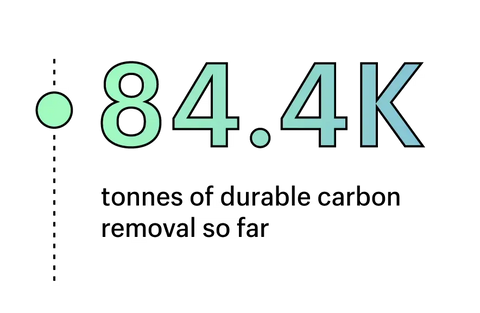Company
Shopify is all-in on carbon removal – here’s what we did in 2023
December 15, 2023

By Stacy Kauk, Head of Sustainability at Shopify
Climate change is the biggest challenge of our time. No single solution will solve it alone. That makes it a meaty, complex, and multi-layered problem—exactly the type Shopify loves to solve.
Even if emissions stopped today, there’d still be too much carbon in the atmosphere. That’s why our Sustainability Fund is obsessed with advancing and expanding the market for carbon removal technologies.
Here are three things we learned about carbon removal in 2023, and where we want to see progress in 2024.
The market for carbon removal is growing… but not fast enough
Shopify believes in the power of entrepreneurship—and we apply this principle to our carbon removal choices. We look for tech-driven climate entrepreneurs around the world who share our values and believe, as we do, that we must innovate our way to a sustainable future.
Last summer, Running Tide completed the world’s first open ocean carbon removal project. We were their first customer, helping to fund their research. Our contribution to their pilot project removed 100 tonnes of carbon dioxide from the atmosphere for more than 1,000 years by sinking biomass to the ocean floor. They’re one of many companies in our portfolio making big moves in their domains.
But carbon removal is a big, gnarly problem that can’t be solved by Shopify and other corporate buyers alone. We’re doing our part to kickstart the market, but it will take way more than just us.
In 2022, Shopify co-founded the world’s first advance market commitment (AMC) for carbon removal: Frontier. Along with Stripe, Alphabet, Meta, and McKinsey Sustainability, we accomplished a lot this year:
- May: Shopify and other Frontier buyers signed a total of $53 million in offtakes from Charm Industrial to remove 112,000 tons of CO₂ between 2024 and 2030. Offtakes are commercial contracts where you pay when the credits are delivered.
- September: Shopify, Stripe, and H&M pre-purchased a combined total of $7 million of carbon removal from 12 early-stage companies. Pre-purchases provide a small injection of interest-free capital and send an important market signal.
- November: Shopify and other Frontier buyers signed a total of $46.6 million in Direct Air Capture (DAC) offtakes with Heirloom and CarbonCapture Inc.
- December: Shopify and other Frontier buyers signed a combined total of $57.1 million in offtake agreements for enhanced weathering (accelerating the natural storage of carbon in rocks) with Lithos Carbon to remove 154,000 tons of CO₂ between 2024 and 2028. This was the world’s first enhanced weathering offtake.
Shopify is empowering sustainable commerce and has made significant impacts on the carbon removal market since launching our Sustainability Fund more than four years ago.
Key stats from 2023:



|
2024 lookahead 👀 Carbon removal technology is taking off. Many pioneering companies have achieved technical milestones while gaining proof of concept and running pilot projects, and a few companies are working on their first large deployment. Progress is here! Still, we need more action to accelerate impact. In 2024, we want to see:
|
We need to hold ourselves & the climate industry accountable
This spring, we shared Shopify’s 2022 Climate Report, our scorecard to assess the performance of the Sustainability Fund, our portfolio companies, and the state of the carbon removal market.
We named three key areas that are essential to the supply and affordability of carbon removal in the long-term, and documented where they stood at the beginning of 2022:
- Technology: development is progressing well but deployment has some challenges
- Financing: promising ideas need funding before their first buyer
- Commercialization: policy support is growing, but Measurement, Reporting, and Verification (MRV) still needs real solutions
We’re working on our 2023 Climate Report which we’ll share next year. My early take? 2023 was even stronger than 2022.
This year, more of our portfolio companies moved from prototype to pilot than ever before. Project developers stepped up and expedited progress. But it’s not all rosy: venture funding has been a challenge for some companies.
On the MRV front, Puro and Isometric have introduced new carbon removal protocols, and the EU aims to establish a certification framework in Europe. CarbonPlan and Frontier’s work on verification confidence levels has helped set a standard, but even with all of this, we need more action to tackle uncertainty.
|
2024 lookahead 👀
We need to build a market and build trust in that market if we want to scale carbon removal meaningfully. In 2024, we want to see:
|
We need to make carbon removal more accessible
We’ve revamped our Planet app, connecting Shopify merchants with the incredible companies in our Sustainability Fund. With Planet, merchants can offer carbon-neutral shipping on every order. It's a triple win: entrepreneurs can easily offset carbon emissions from their order shipments, delight their sustainability-focused customers, and drive demand for carbon removal.
So far, Shopify merchants have used Planet on millions of orders, purchasing high-quality carbon removal from companies within our fund. We also introduced new ways for merchants to share their progress with their customers. Customizable badges can now display a business' own carbon removal contributions to companies like Heirloom, Running Tide, Grassroots Carbon, Remora, and more.
And for the fourth straight year, Shopify neutralized the carbon emissions from shipping every single order made through our platform over the Black Friday-Cyber Monday (BFCM) weekend. We used a rigorous formula built by Shopify data scientists, and worked with our fund partners to remove CO₂ emissions equal to the entire BFCM shipping footprint.
Key stats from 2023:



|
2024 lookahead 👀
Along with making carbon removal accessible to more types of businesses, we also need to reduce emissions more broadly in commerce. In 2024, we want to see:
|
The carbon removal market is at a truly historic moment in time, bursting with new ideas. More entrepreneurs are pursuing innovative solutions with increased investments coming from the market.
As much as we hate dampening our enthusiasm, we need to be very clear here: there is still a loooong way to go, and we can’t afford to wait.
Next year, let’s head down that road together. Let’s close the gap between where we are and where we need to be. Let’s do it for our planet, for future generations, for ourselves, and for the simple fact that it’s about freakin’ time.